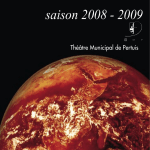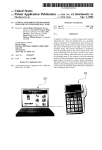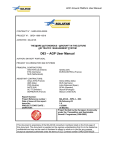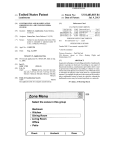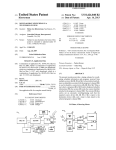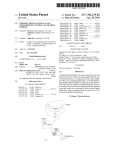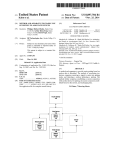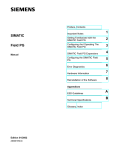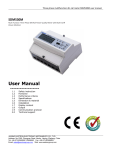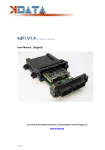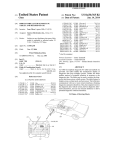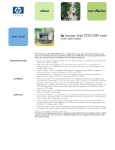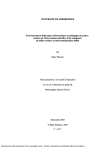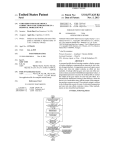Download Interactive device with sound-based action synchronization
Transcript
USOO8715031B2 (12) United States Patent (10) Patent N0.: Fong et a]. (54) (45) Date of Patent: 4,717,364 A 1/1988 Furukawa SOUND_BASED ACTION 4,840,602 A 4,949,327 A 6/1989 Rose 8/1990 Forsse et al. SYNCHRONIZATION 5,145,447 A * Inventors: Peter Sui Lun Fong, Monterey Park, CA 9/1992 Notice: (US); Xi-Song Zhu, ShenZhen (CN); 6,514,117 B1 2/2003 Hampton et a1. 6,609,979 B1 * 8/2003 Wada ~~~~~~~~~~~~~~~~~~~~~~~~~~~~ ~~ 463/43 CA (Us) 6,682,392 B2 7,120,257 B2 * cited by examiner Aug. 6, 2009 Prior Publication Data Int. Cl. A63H 30/00 (52) us CL Assistant Examiner * Alex F. R. P. Rada, II ’ (74) Attorney, Agent, or Firm * Stetina Brunda Garred & (51) (56) ......................... .. 446/268 Primary Examiner * William Brewster Feb 10 2011 ' Zh Elan Microelectronics C0111, “User’s Manual” D00 VefSiOIl 13, MW 2007 MacroniX International Co., Ltd. “MXIC” Oct. 13, 2005. Elan Microelectronics Corp., “Reference Guide” Doc. Version 1.3, (22) Us 2011/0034103 A1 6/2008 eng OTHER PUBLICATIONS ch~ 2007 (65) 1/2004 Chan 10/2006 Mahoney 2008/0139080 A1* (21) App1.No.: 12/536,690 (58) t l. Kelvin Yat-Kit Fong, Monterey Park, Subject to any disclaimer, the term of this patent is extended or adjusted under 35 U_S_C_ 154(b) by 1279 days_ Filed: Goldfarb ..................... .. 446/408 12/1996 Nakad 6,312,307 B1 * 11/2001 Dean, i116”? .................. .. 446/297 (73) Assignee: Peter Sui Lun Fong, Monterey Park, CA (US) (*) May 6, 2014 INTERACTIVE DEVICE WITH 5,587,545 A * (75) US 8,715,031 B2 Brucker (2006.01) (57) ABSTRACT USPC ------------- -- 446/ 175; 446/297; 446/484; 463/ 1; An interactive amusement device and a method therefor are 463/7; 463/30; 463/43 Field Of ClaSSi?catiOIl SeaI‘Ch USPC ---------------- -- 463/1, 7, 30*31, 4(L43; 434/118, _ _ 434/307 R; 446175, 297: 484 disclosed. The device plays a musical soundtrack in a ?rst game iteration corresponding to a learning mode. A sequence of user input actions received during this learning mode is detected, and timestamps for each is stored into memory. In a see apphcanon ?le for complete searCh hlswry' R f Ct d second game iteration corresponding to a playback mode, the musical soundtrackis replayed.Additionally, an output signal U.S. PATENT DOCUMENTS is generated on at least one interval of the user input actions based on the stored timestamps, and is coordinated With the e erences 4,245,430 A 4,272,915 A 1 e replaying of the musical soundtrack. 1/1981 Hoyt 37 Claims, 13 Drawing Sheets 6/1981 Noble I99 GENERATE INSTRUCTIONAL OOMMAND 200—/ PLAY MUSICAL SOUNDTRACK <———————J 202 _/ DETECT SEQUENCE OF USER INPUT ACTIONS STORE TIMESTAMPS FOR EACH OF THE USER INPUT ACTIONS I DERIVE USER INPUT ACTION TYPES FROM RECEIVED SOUND SIGNALS STORE SOUND SIGNALS OF RECORDED USER INPUT ACTIONS I— LEARNING MODE 205 PLAYBACK MODE 208/ REPLAY MUSICAL SOUNDTRACK I I GENERATE OUTPUT AUDIO SIGNAL BASED 0N TIMESTAMPS I 210 I ACTIVATE MECHANICAL ACTUATORS BASED ON TI MESTAM PS I 212 ACTIVATE ANIMATION BASED ON TIMESTAMPS I 214 US. Patent FIG. 1A May 6, 2014 Sheet 1 0f 13 FIG. 1 B US 8,715,031 B2 HQ. 1 C US. Patent May 6, 2014 Sheet 2 0f 13 US 8,715,031 B2 3” '\ POWER SUPPLY 32 PROGRAMMABLE DATA PROCESSOR 28 ZQ 34 JO 38 I 40 /‘ MEMORY FIG. 2 41 44 46 MUSICAL SOUNDTRACK—> START PLAYBACK OF MUSICAL END PLAYBACK OF MUSICAL SOUNDTRACK/ SOUNDTRACK/ ACTIVATE ACOUSTIC TRANSDUCER DEACTIVATE ACOUSTIC TRANSDUCER FIG. 4 US. Patent May 6, 2014 Sheet 3 0f 13 US 8,715,031 B2 1,99 GENERATE INSTRUCTIONAL COMMAND 200_/ PLAY MUSICAL SOUNDTRACK 202 / DETECT SEQUENCE OF USER INPUT ACTIONS ¢ <-—-—--J ¢ v DERIVE USER INPUT 206 ( STORE SOUND SlggEElmlEgmmgs ACTION TYPES FROM SIGNALS OF USER INPUT ACTIONS RECEIVED SOUND SIGNALS RECORDED USER INPUT ACTIONS I I I 204 I I LEARNING MODE ............................... y 208/ PLAYBACK MODE REPLAY MUSICAL SOUNDTRACK I v GENERATE OUTPUT ACTIVATE MECHANICAL AUDIO SIGNAL BASED ACTUATORS BASED ON ON TIMESTAMPS TIMESTAM PS I Biggg'gT??wysiT/lms I 210 212 FIG. 3 214 US. Patent May 6, 2014 4 8550 US 8,715,031 B2 Sheet 6 0f 13 3%(29 8550 US. Patent May 6, 2014 Sheet 7 0f 13 US 8,715,031 B2 80a 58 62 FIG. 6 US. Patent May 6, 2014 Sheet 9 0113 US 8,715,031 B2 1 NC N0 .51. 13 NC NC 4 PD4 MICPOWER 12 NC U2 NC 5 PB? MICIN FD? BZPOWER 40 ~—:-__~ lL NC 1° vss 9 NC — NC 6— 7 PMZ Q a PA14 s _%_ SPKD]: :22 PBG- l FAB , 1 PM | | PAS ' | PM 26 _/__“ 2 D ID PA? \\ 3 a:ml 00‘E m“I mll a:El q20; "-I2 an“. I w “I 2 2 g g; g g i J' A 1 28 ‘ 31' 2 Q Q 9 > > : 1 E MIC POWER R13 521 9015c 08 5.6K 2: Piezo Transducer + =°"* 7 m $150 - Ema: IN > m R24 012 104 @110 FIG. 7B US. Patent | : May 6, 2014 Sheet 10 0f 13 vcc ‘ A U5 l l: C16 I II I US 8,715,031 B2 /~ 70 Driver 220uF 1" C1? T: ___ IBATI' 220uF l l L— | : I _ vcc A I | i U4 IR receiver 1 10k © K R25 ? '3: Eggl'RANSMITTER I |I ' i I R19 R25 1K Il— 1/ QB 9013H 5:015 100uF 10 : R27 am FIG. TC 011 9013H US. Patent FIG. 9A May 6, 2014 FIG. QB Sheet 12 0f 13 FIG. 9C US 8,715,031 B2 FIG. 9D US. Patent May 6, 2014 Sheet 13 0f 13 POWER ON 300 SLEEP MODE 302 NO US 8,715,031 B2 304 BUTTON PRESSED? RETURN TO SLEEP MODE 302 YES + 306/ CLEAR ALL REGISTERS ENTER DEMONSTRATION MODE I + 318 YES 316 308 I ENTER LEARNING MODE DEACTIVATE TRANSDUCER USER INPUT DETECTED? <—NO REGISTER_O > 2? *‘310 NO-—---> INCREMENT REGISTER_O I 314 YES V CLEAR REGISTERWO ’32!) I ENTER PLAYBACK MODE r322 I INCREMENT REGISTER_1 $324 RETURN TO SLEEP MODE CLEAR ALL REGISTERS I 328 302 US 8,715,031 B2 1 2 INTERACTIVE DEVICE WITH SOUND-BASED ACTION SYNCHRONIZATION Instead of mechanical activation, the child provided a voice command to the doll. The received audio signal was pro cessed by a voice recognition engine to evaluate what com CROSS-REFERENCE TO RELATED APPLICATIONS mand was issued. Based upon the evaluated command, a response was generated from a vocabulary of words and phrases stored in memory. A central processor controlled a speech synthesizer that vocalized the selected response. In conjunction with the vocalized speech, an accompanying Not Applicable STATEMENT RE: FEDERALLY SPONSORED RESEARCH/ DEVELOPMENT 10 musical soundtrack could be generated by an instrument syn thesizer. The central processor could also control various motors that were coupled to the features of the doll in order to simulate life-like actions. These animated toys typically portrayed popular charac Not Applicable ters that appeared in other entertainment modalities such as BACKGROUND 1. Technical Field The present invention relates generally to toys and amuse ment devices, and more particularly, to an interactive toy with sound-based action synchronization. 20 2. RelatedArt dolls, there remain a number of de?ciencies. Some parents and child psychologists argue that these dolls do nothing to stimulate a child’s imagination because they are reduced to Children are often attracted to interactive amusement devices that provide both visual and aural stimulation. In recognizing this attraction, a wide variety have been devel oped throughout recent history, beginning with the earliest 25 “talking dolls” that produced simple phrasings with string activated wood and paper bellows, or crying sounds with weight activated cylindrical bellows having holes along its side. These talking dolls were typically limited to crying “mama” or “papa.” television shows and movies, and accordingly appeared and sounded alike. Some commercially available toys with these interactive features include Furby® from Hasbro, Inc. of Pawtucket, RI. and Bamey® from HiT Entertainment Lim ited of London, United Kingdom. Despite the substantially increased interactivity with these 30 Further advancements utilized wax cylinder phonograph recordings that were activated with manually wound clock reacting passively to a toy, much like watching television. Notwithstanding the increased vocabulary, the limited num ber of acceptable commands and responses has proven inter action to be repetitious at best. Although children may ini tially be fascinated, they soon become cognizant of the repetition as the thrill wears off, and thus quickly lose interest. Accordingly, there is a need in the art for an improved amuse ment device. Furthermore, there is a need for interactive toys with sound-based action synchronization. work-like mechanisms. Various phrases were recorded on the phonographs for playback through the dolls to simulate dia logue. Still popular among collectors today, one historically BRIEF SUMMARY 35 signi?cant embodiment of a talking doll is the “Bebe Pho One embodiment of the present invention contemplates an nographe” made by the Jumeau Company in the late 19th amusement device that may include a ?rst acoustic transducer and a second acoustic transducer. Additionally, the amuse ment device may include a programmable data processor that century. In addition to spoken words, music was also recorded on the phonograph so that the doll could sing songs and nursery rhymes. 40 Thereafter, dolls having an increased repertoire of ten to and an output port connected to the second acoustic trans twenty spoken phrases were developed. The speaking func tion was activated with a pull of a string that activated a miniature phonograph disk containing the pre-recorded phrases. The “Chatty Cathy” talking doll includes such a pull string-activated mechanism. 45 In addition to the aforementioned speaking capabilities, invention, a method for interactive amusement is contem soundtrack in a ?rst game iteration that corresponds to a 50 be correspondingly moved. The instructions required for such synchronized animation of the features of the doll were stored in a cassette recording with the control signals and the audio signal. 55 sponds to a playback mode. Further, the method includes generating in the playback mode an output audio signal on at least one interval of the received sequence of user input 60 ments involved dolls with basic sensors such as piezoelectric improvements in digital data processing and storage, how ever, dolls having greater interactivity became possible. input actions. The timestamps may be synchronized to the musical soundtrack. The method may also include replaying the musical soundtrack in a second game iteration that corre limited to decidedly mechanical modalities such as pulling a buzzers that, when triggered, cause the doll to respond imme diately by outputting a sound or movement. Examples of such devices include the “Interactive Sing & Chat BRUINTM Bear” from Toys ‘R’ Us, Inc. of Wayne, N.J. With substantial learning mode. Additionally, the method includes detecting a sequence of user input actions received during the learning mode. Then, the method continues with a step of storing into memory timestamps of each of the detected sequence of user One de?ciency with these earlier talking dolls was the rather low degree of interactivity between the doll and the child, as the input to trigger speaking and movement was string, turning a crank, or pushing a button. Further improve ducer. The programmable data processor may be receptive to input sound signals from the ?rst acoustic transducer contem poraneously with an audio track being output to the second acoustic transducer. In accordance with another embodiment of the present plated. The method includes a step of playing a musical there have been efforts to make a doll more lifelike with movable limbs and facial features. Further, the movement of such features was synchronized with the audio output. For example, when a phrase was uttered, the jaws of the doll could has an input port connected to the ?rst acoustic transducer, actions based upon the recorded timestamps. The output audio signal may be coordinated with the replaying of the musical soundtrack. According to another embodiment, an animated ?gure amusement device is contemplated. The device may have at 65 least one movable feature. The amusement device may include a ?rst acoustic transducer that is receptive to a sequence of sound signals in a ?rst soundtrack playback US 8,715,031 B2 3 4 iteration. The sequence of sound signals may correspond to a pattern of user input actions associated with the soundtrack. Additionally, the amusement device may include a mechani cal actuator with an actuation element that is coupled to the movable feature of the animated ?gure. The amusement device may also include a programmable data processor that has a ?rst input connected to the acoustic transducer, and a ?rst output connected to the mechanical actuator. The mechanical actuator may be activated by the programmable data processor in synchronization with the received sequence of sound signals in a second soundtrack playback iteration. presently preferred embodiment of the invention, and is not intended to represent the only form in which the present invention may be constructed or utilized. The description sets forth the functions of the invention in connection with the illustrated embodiment. It is to be understood, however, that the same or equivalent functions and may be accomplished by different embodiments that are also intended to be encom passed within the scope of the invention. It is further under stood that the use of relational terms such as ?rst and second, top and bottom, left and right, and the like are used solely to distinguish one from another entity without necessarily requiring or implying any actual such relationship or order between such entities. With reference to FIG. 1A, one exemplary embodiment of In a different embodiment, an amusement device is con templated. The amusement device may similarly have a replayable soundtrack. The amusement device may include a ?rst acoustic transducer that is receptive to a ?rst sequence of sound signals in a ?rst soundtrack playback iteration. The sequence may correspond to a pattern of user input actions an interactive device 10 is an anthropomorphized rabbit FIG. 11 having a body section 12, a pair oflegs 14, a pair of arms 16, and a head 18. In further detail, the head 18 includes a pair associated with the soundtrack. There may also be a program mable data processor that has a ?rst input connected to the ?rst acoustic transducer, and a ?rst output connected to a second acoustic transducer. A second sequence of sound sig nals may be played by the programmable data processor in the second soundtrack playback iteration. In this regard, the sec ond sequence of sound signals may be synchronous with the ?rst sequence of sound signals. The present invention will be best understood by reference to the following detailed description when read in conjunc tion with the accompanying drawings. 20 will be appreciated, the doll FIG. 11 may portray humans, other animals besides rabbits such as dogs, cats, birds and the like, or any other character real or imagined. It will also be appreciated that the foregoing features of the doll FIG. 11 are 25 30 FIGS. 1A-C illustrate an exemplary embodiment of an 35 implemented; 40 FIG. 4 is a plot illustrating an exemplary signal of user 45 The block diagram of FIG. 2 best illustrates the functional components of the interactive device 10. A programmable data processor 26 is central to the interactive device 10, and is 50 con?gured to execute a series of preprogrammed instructions that generates certain outputs based upon provided inputs. wireless transceiver; Speci?cally, the executed instructions are understood to be steps in a method for interactive amusement according to one FIG. 8 illustrates another exemplary embodiment of the interactive device, including an on-board display device; embodiment of the present invention. The pro grammable data FIGS. 9A-9D are illustrations of an animation sequence generated on the on-board display device. 11 are not limited to the head 18 and the ears 24, and any other features may also be movable to simulate various actions being performed by the doll FIG. 11. FIG. 6 illustrates an alternative embodiment of an interac tive device in use; FIG. 7 is a schematic diagram of the alternative embodi ment of the interactive device including a display driver and a has a resting position as shown in FIG. 1A, an intermediate position as shown in FIG. 1B, and an extended position as shown in FIG. 1C. Those having ordinary skill in the art will recognize that the movement of the features of the doll FIG. input actions generated by an acoustic transducer; FIG. 5 is a schematic diagram illustrating the embedded systems components of the interactive device including a central processor, a memory device, a pair of mechanical actuators, and acoustic transducers; and ears 24 are capable of rotating or “?apping” about the head 18. In further detail, FIG. 1A shows the ears 24 in a resting position, FIG. 1B shows the ears 24 in an intermediate posi tion, and FIG. 1C shows the ears 24 in an extended position. As will be described in further detail below, the movement of the ears 24 between the resting position, the intermediate position, and the extended position simulate a clapping action being performed by the doll FIG. 11. Similarly, the head 18 FIG. 3 is a ?owchart illustrating the method for interactive amusement; to the body section 12 along with actuators to move those features. For example, as shown in FIGS. 1B and 1C, the head 18 is capable of pivoting about the body section 12, and the respect to the following description and drawings, in which: interactive device in various states; FIG. 2 is a functional block diagram of the interactive toy in accordance with one embodiment of the present invention, whereupon a method for interactive amusement may be presented by way of example only, and not of limitation. It is contemplated that the various features of the doll FIG. 11 are animated, i.e., movable, and have appropriate under lying support elements and joint structures coupling the same BRIEF DESCRIPTION OF THE DRAWINGS These and other features and advantages of the various embodiments disclosed herein will be better understood with of eyes 20, a mouth 22 and a pair of ears 24. Where appro priate, each of the ears 24 will be referenced individually as right ear 24a and left ear 24b, and collectively as ears 24. As 55 FIG. 10 is a detailed ?owchart illustrating one exemplary processor 26 is understood to have an arithmetic logic unit, various registers, an instruction decoder, and a control unit, as software application being executed by the central processor is typical of data processing devices. An internal random to implement the interactive device according to an embodi ment of the present invention. Common reference numerals are used throughout the drawings and the detailed description to indicate the same elements. access memory may also be included. By way of example, the programmable data processor 26 is l6-bit digital signal pro 60 poration of Hsinchu, Taiwan, though any other suitable IC devices may be readily substituted without departing from the DETAILED DESCRIPTION 65 The detailed description set forth below in connection with the appended drawings is intended as a description of the cessing (DSP) integrated circuit. One commercially available option is the eSL Series IC from Elan Microelectronics Cor scope of the present invention. The programmable data processor 26 has a plurality of general-purpose input/output ports 28 to which a number of peripheral devices are connected, as will be described below. US 8,715,031 B2 5 6 The programmable data processor 26 is powered by a power supply 30, which is understood to comprise a battery and conventional regulator circuitry well known in the art. According to one embodiment, among the input devices con memory module 40 is the MX25L3205D device from Macronix International Co., Ltd. of Hsinchu, Taiwan. The particular external memory module 40 is understood to have a 4 megabyte or 32 megabit capacity. In some embodiments, it is contemplated that the soundtrack and the output sounds may be stored in a memory internal to the programmable data processor 26. The eSL IC mentioned above, for example, is understood to have 1 megabyte of internal memory. In playing back the soundtrack stored in the external memory module 40, the data is ?rst retrieved from the same nected to the programmable data processor 26 are a piezo electric transducer 32, and control switches 34. With respect to output devices, the programmable data processor 26 is also connected to a speaker 36 and mechanical actuators or elec tric motors 38. According to one embodiment of the present invention, the piezoelectric transducer 32 and the speaker 36 are embedded within the doll FIG. 11. As is typical for dolls that depict animals and other characters that appeal to children, the doll by the programmable data processor 26, and then an analog audio signal is generated with the sound synthesizer. This audio signal is then output through the speaker 36. Prior to playing the musical soundtrack, however, there FIG. 11 may be covered with a thick fabric material. There fore, the respective diaphragms of the piezoelectric trans may be a prefatory step 199 of generating an audible instruc tional command. This instructional command may describe in a user-friendly manner the general format of the preferred input sequence. Further details pertaining to the method of ducer 32 and the speaker 36 are disposed in substantial prox imity to its exterior so that input sounds can be properly detected and output sounds can be properly heard without any muf?ing effects. The control switches 34 are similarly embedded within the doll FIG. 11 but are also disposed in proximity to its exterior surface for ready access to the same. As will be described in further detail below, the control switches 34 may be power interactive amusement will be subsequently described, but 20 instructional command: “Hello! I feel like singing! That’s great! You can help me out by clapping your hands!” Another exemplary instructional command is as follows: “I sure could use your help with the dance moves! Just clap when my ears switches and mode-changing switches. Along these lines, the power supply 30 is also embedded within the doll FIG. 11, 25 As indicated above and shown in FIGS. 1A-1C, the head 18 30 thereto. Speci?cally, the actuation element of the electric motors 38, that is, its rotating shaft, is coupled to the movable elements of the doll FIG. 11. Conventional gearing tech niques well known by those having ordinary skill in the art may be employed therefor. In the block diagram of FIG. 2, the pair of the electric motors 38 corresponds to the head 18 and the ears 24. Based on the output signals generated by the programmable data processor 26, the ears 24 can be selec tively moved. It is also contemplated that the electric motors 38 be coupled to other movable features of the doll FIG. 11, including the legs 14 and the arms 16. In addition to the visual stimuli provided by the animation of the various features of the doll FIG. 11, it is also contem plated that the interactive device 10 provides aural stimula tion. The programmable data processor 26 is understood to 35 40 45 32, which generates a corresponding analog electrical signal 50 Having set forth the basic components of the interactive ered. One embodiment of the present invention contemplates 55 piezo buzzer or a piezo ceramic disc or plate, effectively excludes any lower frequency sounds of the musical soundtrack. In order to distinguish more reliably between the soundtrack and the user input action, the piezoelectric trans ducer 32 may be isolated, that is, housed in separate compart ments, from the loudspeaker 36. Alternatively, the piezoelec able features of the doll FIG. 11. It is contemplated that step tric transducer 32 may be disposed in a location anticipated to be closer to the source of the user input than that of the 200 occurs in a ?rst game iteration that corresponds to a 60 loudspeakers. At or prior to initiating the playback of the musical soundtrack during the learning mode, the piezoelec As shown in the block diagram of FIG. 2, the interactive tric transducer 32 is activated. When the musical soundtrack device 10 includes an external memory module 40, in which a digital representation of the soundtrack, as well as output sounds, may be stored. Although any suitable memory mod ?ash memory device. One commercially available external to an input of the pro grammable data processor 26. The piezo electric transducer 32, which is also known in the art as a device 10, the functional interrelations will now be consid ule may be used, the external memory module 40 in one embodiment of the present invention is a read-write capable tion contemplates an amusement device capable of receiving a sound input via the piezoelectric transducer 32 while at the same time producing a sound output via the loudspeaker. As will be described further below, additional simultaneous inputs from a microphone are also contemplated. By way of example only, the user claps his or her hands to generate a short, high-frequency sound that is characteristic of such a handclap. Any other types of sonic input such as and so forth may also be provided. This sound is understood to have a level suf?cient to trigger the piezoelectric transducer signal. These sound signals may be representative of spoken learning mode. mode, a sequence of user input actions is received and detected according to step 202. More particularly, the user provides some form of an audio input that marks an instant in time relative to, or as synchronized with, the soundtrack that those produced by percussion instruments, clappers, drums, range based upon a discrete-time representation of the sound a method for interactive amusement that may be implemented with the interactive device 10. With reference to the ?owchart of FIG. 3, the method begins with a step 200 of playing a musical soundtrack with or without moving any of the mov The audio signal of the instructional command is digitally stored in the memory module 40 and retrieved for playback. While the musical soundtrack is playing in the learning is simultaneously being played back. Thus, the present inven have sound synthesizing functionality, that is, the functional ity of generating an analog signal in the sound frequency dialogue or a musical soundtrack. should ?ap! Here goes!” It will be appreciated that numerous variations in the phrasing of the instructional command are possible, and so the foregoing examples are not intended to be limiting. The vocalization of the instructional command may also be varied, and may be accompanied by a musical score. with access covers to the batteries being disposed on the exterior surface of the same. and the ears 24 of the doll FIG. 11 are movable, and the electric motors 38 are understood to be mechanically coupled may be generally described in the following exemplary 65 ?nishes playing, the programmable data processor 26 may stop accepting further inputs from the piezoelectric trans ducer 32, or deactivate it altogether. It will be appreciated that the piezoelectric transducer 32 is presented by way of example only, and any other modalities US 8,715,031 B2 7 8 for the detection of the user input actions may be readily substituted. For example, a conventional wide dynamic range templates the reception of user input actions solely with the piezoelectric transducer 32, and it will be appreciated that the microphone may be utilized in conjunction with high pass ?lter circuits such that only the high frequency clap sounds that allows for more execution alternatives from different user addition of the microphone 33 represents a further re?nement inputs. Amongst the characteristics derived from the analog signal include the amplitude, frequency, and duration of each are detected. Instead of incorporating additional circuitry, however, the raw analog signal as recorded by such a conven tional microphone may be input to the programmable data sound signal, the different combination of which may be processor 26. The analog signal may be converted to a dis variously categorized into the user input action types. More sophisticated analyses of the user input action types built upon the basic amplitude, frequency, and duration char crete-time representation by an analog-to -digital converter of the programmable data processor 26, and various signal pro cessing algorithms well known in the art may be applied to extract a signal of the clapping sounds. Although the present acteristics are also contemplated, such as rhythm, tempo, tone, beat, and counts. For example, a hand clap may be distinguished from a whistle, a drum beat, and any other type of sound. Additionally, it is also contemplated that a sequence of user input actions may be matched to a prede?ned pattern as being representative of a characteristic. By way of example, such a prede?ned pattern may include a sequence of disclosure describes various features of the interactive device 10 in relation to the functionality of the piezoelectric trans ducer 32, it is understood that such features are adaptable to the alternative modalities for detecting the user input actions. With reference to the plot of FIG. 4, a condensed represen tation of a user input signal 41 that corresponds to the clap ping sound inputs is shown. The signal 41 is de?ned by a starting point 42 at which the musical soundtrack begins playing and the piezoelectric transducer 32 is activated. Each one or more progressively quieter hand claps, or a sequence of 20 claps that alternate variously from quiet to loud. It will be appreciated that any pattern of user input actions varying in the above characteristics could be prede?ned for recognition small tick mark 44 represents an equal time interval of the upon receipt. musical soundtrack, and larger tick marks 46 represent the In addition to deriving the user input action types, the sound signal may also be recorded for future playback, as will instant in time when the clapping sound was detected. The signal 41 is also de?ned by an ending point 48 at which the musical soundtrack ends playing and the piezoelectric trans 25 where it is converted to a digital representation, and stored in memory. Since each detected instance of the user input actions may have different sounds, all of the sound signals are ducer 32 is deactivated. The small tick marks 44 are understood to have a corre sponding timestamp associated therewith. Considering that each of the large tick marks 46 overlap with one of the small tick marks 44, the timestamp is also associated with each moment a clapping sound was detected, and each handclap is linked to a particular playback position of the musical soundtrack. Referring again to the ?owchart of FIG. 3, step 204 includes storing into memory these timestamps for when be explained below. Again, the analog signal from the micro phone 33 is input to the programmable data processor 26, 30 separately recorded and stored. After storing the timestamp for the last of the detected user input actions, the learning mode concludes. In a subsequent, second iteration that corresponds to a playback mode, the method continues with a step 208 of replaying the musical the user input actions were detected. To ensure real -time write soundtrack. As noted previously, playing the musical soundtrack includes retrieving the digital representation of speeds, the timestamps may be stored in the local random the same from the memory module 40 and generating an access memory of the programmable data processor 26. The programmable data processor 26 includes a timer module that utilizes an external clock signal oscillating at a analog signal that is output to the speaker 36. While replaying the musical soundtrack, and in coordina 35 40 prede?ned frequency. The timer module is understood to generate a time value when queried. The timer may be reset to zero at the starting point 42, and the time value may be provided in seconds, milliseconds, or other standard measure of time which are then stored as the timestamp. was detected a user input action or handclap, an output audio 45 Alternatively, where the programmable data processor 26 does not include a timer, the instruction cycle count value may be utilized to derive the timestamp. Given a consistent oper 50 domly generated for each of the timestamps/user input actions. The same pre-recorded sound may be generated for 55 timestamp. For reasons that will be set forth in greater detail below, in addition to storing the timestamps of each of the detected user input actions, the method may also include a step 205 of musical soundtrack. In other words, the output audio signal is synchronous with the user input signal 41. In one embodiment, the output audio signals are pre-re corded sounds. Different pre-recorded sounds may be ran count value is therefore suitable as a reliable timestamp. In order to ascertain the elapsed time between each of the user input actions, the instruction cycle count value may be incre mented at each instruction cycle, with the particular value at the time of detecting the user input action being stored as the signal is generated. It is contemplated that such output audio signals are synchronized with the playback of the musical soundtrack, that is, the sequence of handclaps performed during the learning mode is repeated identically, in the play back mode with the same pattern and timing relative to the ating frequency of the programmable data processor 26, it is understood that the time interval between each cycle is simi larly consistent. A unit measure of time may thus be derived from multiple instruction cycles, so the instruction cycle tion therewith, the method continues with a step 210 of gen erating an output audio signal based upon the stored times tamps. More particularly, at each time interval where there each of the timestamps/user input actions. It will be appreci ated that any type of pre-recorded sounds may be utilized. Additionally, different pre-recorded sounds may be played corresponding to different user input action sequences detected during the learning mode. As indicated above, the characteristics with the aforementioned signal processing number of claps, the pattern of the claps, and so forth may be designated for a speci?c kind of output. In a different embodiment, the output audio signals are the sound signals of the user input actions recorded in step 206. As indicated above, the sound signals corresponding to each of the timestamps or user input actions are individually recorded, so the output audio signals are understood to be algorithms. As previously noted, one basic embodiment con generated in sequence from such individual recordings. deriving user input action types from the received sound signals and storing that as well. In this regard, the analog signal from a microphone 33 may be input to the program mable data processor 26, where it is analyzed for certain 60 65 US 8,715,031 B2 10 larly implemented thereon. A player 58 views and interacts with a graphical display device 60 capable of displaying Along with generating an output audio signal, in a step 212, mechanical actuators or electric motors 38 are activatedbased animations of a character 61 and generating the appropriate output sounds as previously described. Similar to the doll FIG. 11, the character 61 may portray humans and animals such as rabbits, dogs, cats, birds, and so forth, and include features that can be animated including the legs 14, the head 18, the eyes 20, the mouth 22, and the ears 24. Generally, such upon the stored timestamps. At each time interval in which a user input action was detected, the electric motors 38 are activated. This is effective to move, for example, the ears 24 of the doll FIG. 11 in an apparent clapping action. The acti vation of the electric motors 38 is synchronized with the output audio signals, so visually and aurally the doll FIG. 11 claps to the musical soundtrack in the playback mode exactly as performed by the user in the learning mode. It is expressly contemplated, however, that the electric motors 38 need not animated features are understood to correspond to the mov able physical features of the doll FIG. 11. In this regard, the method for interactive amusement includes a step 214 of activating the animations based on the timestamps. The graphical display device 60 may be a conventional be activated for every timestamp or detected instance of user input actions. Depending on the pattern of the user input actions detected, a different corresponding movement may be produced, that is, a different sequence of motor activations television set having well-known interfaces to connect to a console device 62 that generates the audio and graphical outputs. According to one embodiment, the console device 62 is a commercially available video game system that may be loaded with a variety of third-party game software, such as the may be generated. Furthermore, although the output audio signals are typically played back in combination with the movement of the doll FIG. 11, it is also envisioned that these outputs may be separate, that is, the movement of the ears may occur without the output audio signals, and vice versa. The schematic diagram of FIG. 5 provides a more speci?c illustration of an exemplary circuit utilized in one embodi ment of the interactive device 10. As indicated above, the programmable data processor 26 includes general-purpose input/output ports 28, labeled as PAO-PA15, PBO-PB15, and PCO-PC7. Although the speci?c programmable data proces PlayStation from Sony Computer Entertainment, Inc. of 20 25 sor 26 includes two 16-bit wide ports (PortA and Port B) and an 8-bit wide port (Port C), not all pins are utilized, so are not 30 ?rst motor 3811 may be mechanically coupled to the ears 24, and the second motor 38b may be mechanically coupled to the head 18. It will be appreciated that the programmable data processor 26 generally does not output suf?cient power to drive the electric motors 38 nor is it suf?ciently isolated. 35 40 45 recognize the particular signals that are necessary to drive the electric motors 38. Along these lines, there may be sensors that monitor the operation of the motors 38, the output from which may be fed back to the programmable data processor other instructional commands are output through the speaker associated with the display device 60. In this embodiment, the remote controller 64 need not include a loudspeaker. It will be recognized that the isolation of the microphone 33 in the remote controller 64 from any sound output source in this way is bene?cial for reducing interference from the musical 50 motors 38 described herein are not intended to be limiting, soundtrack during the learning mode. Further ?ltering of the recorded sound signal is possible with the digital signal pro cessing algorithms on the programmable data processor 26. Alternatively, the loudspeaker may be included in the remote controller 64 for playing back the musical soundtrack and/or and any other con?guration may be substituted. Pins PAO and PA1 are connected to the speaker 36, and pins PC4 and PC7 are each connected to the piezoelectric trans ducer 32 and the microphone 33. Furthermore, Pins PA12 generated on the display device 60. The embedded program mable data processor 26 then stores the timestamps for each of the user input actions and derives the user input action types. During the learning mode, the musical soundtrack and between the electric motors 38 and the programmable data processor 26, to amplify the signal power and reject reverse 26 for precise control. The speci?c implementation of the 40. As with the ?rst embodiment, the amusement device begins with playing a musical soundtrack and detecting a sequence of user input actions with the piezoelectric trans ducer 32 and the microphone 33 included in the remote con troller 64. In coordination with the received user input actions, accompanying animations and/or images may be Accordingly, driver circuitry 52 serves as an interface voltage spikes. Those having ordinary skill in the art will ment device. With reference to the schematic diagram of FIG. 7, the remote controller 64 may include a device circuit 66 with the programmable data processor 26, the piezoelectric transducer 32, the microphone 33, and the memory module chip control pins are connected in accordance with conven tional practices well known in the art. Pins PA2 and PA3 are connected to a ?rst motor 3811, while pins PA6 and PA7 are connected to a second motor 38b. The preloaded thereon. These dedicated video game consoles are also referred to in the art as “plug N' play” devices. In accordance with one embodiment of the present inven tion, the console device 62 communicates with a remote controller 64 to perform some functionalities of the amuse depicted. The clock frequency of the programmable data processor 26 is provided by an oscillator crystal 50 connected to the OSCO and OSCl ports. Various positive and negative power supply pins are connected to the power supply 30, and Tokyo, Japan, or the Xbox from Microsoft Corp. of Red mond, Wash. Alternatively, the console device 62 may be a dedicated video game console with the appropriate dedicated software to generate the audio and graphical outputs being 55 the output sound signals along with the loudspeaker associ PA15 are connected to the memory module 40. In this con ated with the display device 60. ?guration, data transfers and addressing are performed serially, though it will be appreciated that parallel data trans fers and addressing are possible with alternative con?gura In one implementation, the timestamps and associated user input action types are sent to the console device 62. With this input, the software on the console device 62 generates the tions known in the ?eld. With reference to the illustration of FIG. 6, another embodiment of the present invention contemplates an amuse ment device that is independent of the doll FIG. 11. As will be described in greater detail, the various components of such alternative embodiment ?nd correspondence to the features of the amusement device 10 noted above. It will be recog nized that the method for interactive amusement can be simi 60 65 graphics for the animations and the sound outputs. The circuit 66 includes a radio frequency (RF) transceiver integrated circuit 68 that is connected to the programmable data proces sor 26 via its general purpose input/output ports 28 for receiv ing and transmitting data. It will be appreciated that any suitable wireless transceiver standard or spectrum may be utilized, such as the 2.4 GHz band, Wireless USB, Bluetooth, or ZigBee. Over this wireless communications link, the US 8,715,031 B2 11 12 timestamps, the user input action types, and as applicable, the recorded sound signals of the user input actions are transmit other locations on the doll FIG. 11. Alternatively, there may be a single LED having single or multiple color output capa bilities that ?ash in different colors and patterns according to user input action types. As indicated above, the doll FIG. 11 ted. The console device 62 may include another RF trans ceiver integrated circuit and another pro grammable data pro cessing device to effectuate data communications with its counterparts in the remote controller 64. It will be appreciated by those having ordinary skill in the art, however, that a wired may take a variety of different forms, such as a robot, a vehicle, etc. Along with a direction control pad 72 and pushbuttons 74, the on-board display device 70 may include input capabili link may be utilized. Instead of or in conjunction with the television set, the animations may be displayed on an on-board display device ties, i.e., a touch- sensitive panel may be overlaid. With the use of such a touch sensitive panel, the direction control pad 72 70, which may be a conventional liquid crystal display (LCD) device. The animations are generated by the programmable and the pushbuttons 74 may be eliminated. Those having ordinary skill in the art will recognize that numerous types of data processor 26 based upon the timestamps and the user input action types. The on-board display device 70 may be a touch-sensitive panels are available. Amongst the most popu lar is the capacitive touchpad that detects the position of a ?nger of a touch-sensitive area by measuring the capacitance grayscale device capable, a color device, or a monochrome device in which individual display elements may be either on variation between each trace of the sensor. The touch inputs are converted to ?nger position/movement data to represent cursor movement and/ or button presses. The additional inputs are contemplated for the selection of additional options in the or off. As noted above, it is contemplated that various animations are generated on the display device 60 and/or the on-board the animation may be advanced in synchrony with the playback mode. Referring again to the illustration of FIG. 6, the interface displayed on the graphical display device 60 received user input actions, or one animated sequence may be includes a left column 76 and a right column 78, which displayed at each detected user input action. Where the ani mation is linked to the user input actions in these ways, the display device 60 and/or the on-board display device 70 may output a default animation different from those speci?c ani mations associated with user input actions as the soundtrack include icons 80, 82, respectively. The icons 80, 82 are posi tioned to correspond to the relative segregated regions on the touch-sensitive on-board display device 70. Thus, the on board display device 70 may also output reduced-size repre sentations of the icons 80, 82. It is also possible, however, to is replayed. For example, where the depicted character 61 eliminate the on-board display device 70, and only the touch display device 70. During the learning mode, the frames of exhibits substantial movement when the user input action is detected or a timestamp so indicates, the default animation may involve just a minor movement of the character 61. 20 25 30 By way of example only and not of limitation, the selection Furthermore, it is contemplated that such animations are gen erated on the display device 60 and/or the on-board display device 70 during the playback mode, which are likewise coordinated with the received user input actions as recorded of one of the icons 80 in the left column 76 is understood to select a speci?c animation of a feature of the character 61 that 35 in the timestamps. The display of animations on on-board display devices is left column icon 800 activates the animation of the legs 14, 40 45 lizing the LED array display 84, though any other sequence such as a moving equalizer, beating drum, and so forth may be 50 between changing from one frame to another, may be varied. As previously noted, one contemplated embodiment outputs the animation on the LED array display 84 during the play 55 signals, along with the musical soundtrack, may be digitally 60 mixed according to well-known DSP algorithms prior to con version by a digital-to-analog converter (DAC) and output to the loudspeaker. It is expressly contemplated that other types of animations and sounds may be provided, and the user’ s selection thereof can be differed to correspond to such variations. In the exemplary embodiment shown, the LED array dis play 84 is mounted to the body section 12 of the doll FIG. 11. It will be appreciated, however, that the LED array display may be of any size or con?guration, and may be mounted in speaker. Accordingly, the various analog sound signals gen erated by the programmable data processor 26 may be mixed. However, it is also contemplated that the various output sound 84 during the learning mode as the user input actions are received. When utilizing the microphone 33 and variations in user input action types are discernible (e.g., progressively louder hand-claps, etc. as mentioned above), the animations Selection of a ?rst right column icon 8211 is understood to generate a trumpet sound, and selection of a second right column icon 82b generates a “spring” or “boing” type sound. Furthermore, selection of a third right column icon 820 gen erates a bike horn sound, while selection a fourth column icon 82d generates a drum sound. In some embodiments, different output channels may be assigned to a particular sound, with each of the output channels being connected to the loud back mode. In this case, the display of each frame or session is based upon the recorded timestamps much like the output audio signals and the movement of the various features of the doll FIG. 11 by the electric motors. Another contemplated embodiment outputs the animation on the LED array display The selection of one of the icons 82 in right column 78, on the other hand, is understood to select a particular output sound signal that is generated according to the timestamps. shown. FIGS. 9A-9D depict one possible animation sequence uti readily substituted. The animation speed, that is, the delay and selection of a fourth left column icon 80d activates the animation of a tail. Upon selection of any of the icons 80, visual feedback is provided by placing an emphasis thereon, such as by, for example, highlights. ous images can be shown. Further, by sequentially activating a combination of the LED elements 86, animations can be is activated according to the timestamps. For example, selec tion of a ?rst left column icon 8011 activates the animation of the mouth 22, while a selection of a second left column icon 80b activates the animation of the ears 24. Selection of a third not limited to those embodiments with the console device 62. As best illustrated in FIG. 8, another example of the doll FIG. 11 includes a Light Emitting Diode (LED) array display 84 that includes a plurality of individually addressable LED elements 86 that are arranged in columns and rows. By selec tively activating a combination of the LED elements 86, vari sensitive panel may be included on the remote controller 64. Thus, no graphical output will be generated on the remote controller 64. 65 may be accomplished by navigating the interface with the direction control pad 72 and the input buttons 74, for example. One selection made during the learning mode may be made applicable to all of the user input actions during the























